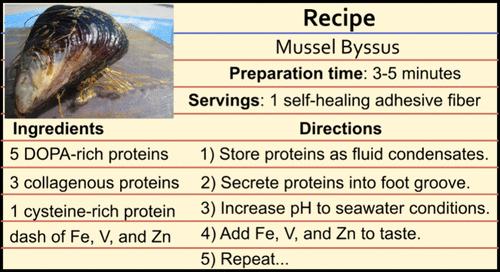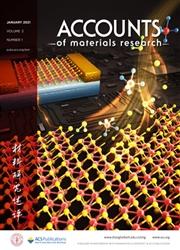Why and How to Investigate Biological Materials Processing: A Cross-Disciplinary Approach for Inspiring Sustainable Materials Fabrication
IF 14
Q1 CHEMISTRY, MULTIDISCIPLINARY
引用次数: 0
Abstract
Enhancing the performance and sustainability of materials is a major challenge facing humanity. With nearly 400 million tons of plastics manufactured per year and plastic waste accumulation of 12 billion tons expected by 2050, the production and buildup of anthropogenic petroleum-based waste is a major threat to our global ecosystem. This impending environmental catastrophe demands alternative sustainable and circular routes for material production. Additionally, there is a need for new polymeric materials that possess properties not currently found in synthetic materials for various applications in biomedical engineering, soft robotics, flexible electronics, and more. Nature offers inspiration for solving both of these environmentally, economically, and socially impactful global issues. Indeed, living organisms, such as spiders and mussels, rapidly fabricate polymeric biological materials from biomolecular building blocks (e.g., proteins) under green, environmentally benign processing conditions. These materials exhibit properties that surpass many synthetic plastics (e.g., high toughness, self-healing, “smart” adaptability, underwater adhesion), providing a blueprint for how humans can develop sustainable fabrication practices for producing next-generation materials. There is now a solid understanding of the structure–function relationships defining the performance of many biological materials, with control of structural hierarchy from nanoscale to centimeter scale emerging as a common design feature. Yet, it has been extremely challenging to replicate this hierarchical structure and, thus, the relevant properties in synthetic materials. This is largely due to a poor understanding of how these materials are fabricated by living organisms. Indeed, elucidation of the physicochemical principles underlying the fabrication of these and similar materials is significantly hampered due to experimental challenges in following these dynamic processes at the relevant spatiotemporal scales. Here, I outline a cross-disciplinary experimental approach spanning organismal biology, molecular biology, biochemistry, physical chemistry, and materials science for extracting design principles from biofabrication processes. As a model system, I focus on the fabrication of the mussel byssus–a biopolymeric fibrous holdfast with outstanding properties (underwater adhesion, high toughness, self-healing capacity) that is an established archetype for sustainable bioinspired fibers, glues, composites, and coatings. Careful analysis combining traditional histology and biochemical approaches with advanced spectroscopic imaging (e.g, confocal Raman spectroscopy, FTIR spectroscopy, and micro X-ray fluorescence), tomographic approaches (e.g., micro-CT), and advanced electron microscopy (e.g., focused ion beam scanning electron microscopy (FIB-SEM)) have yielded deep insights into the byssus assembly process, highlighting the key role of fluid protein condensates (liquid crystals and coacervates), microfluidic-like mixing, and protein–metal coordination bonds, as well as various physicochemical triggers (e.g., pH, redox, mechanical shear) that promote the self-organization and cross-linking of stimuli-responsive protein building blocks. Extracted concepts are already being applied for enhancing the sustainable fabrication of bioinspired materials for technical and biomedical applications.

为什么以及如何研究生物材料加工:激发可持续材料制造的跨学科方法
提高材料的性能和可持续性是人类面临的重大挑战。预计到2050年,全球每年生产近4亿吨塑料,塑料废物累积量将达到120亿吨,人为石油废物的产生和积累对全球生态系统构成了重大威胁。这种迫在眉睫的环境灾难需要替代可持续和循环的材料生产路线。此外,在生物医学工程、软机器人、柔性电子等领域的各种应用中,需要具有合成材料中目前没有的特性的新型聚合物材料。大自然为解决这些具有环境、经济和社会影响的全球性问题提供了灵感。事实上,活生物体,如蜘蛛和贻贝,在绿色、环保的加工条件下,从生物分子构建块(如蛋白质)快速制造聚合生物材料。这些材料表现出超越许多合成塑料的特性(例如,高韧性、自愈、“智能”适应性、水下附着力),为人类如何开发可持续的制造实践来生产下一代材料提供了蓝图。现在,人们对定义许多生物材料性能的结构-功能关系有了坚实的理解,从纳米尺度到厘米尺度的结构层次控制正在成为一个共同的设计特征。然而,在合成材料中复制这种分层结构和相关特性是极具挑战性的。这在很大程度上是由于对这些材料是如何由生物体制造的理解不足。事实上,由于在相关时空尺度上遵循这些动态过程的实验挑战,这些材料和类似材料制造背后的物理化学原理的阐明受到了极大的阻碍。在这里,我概述了一种跨学科的实验方法,涵盖了有机生物学、分子生物学、生物化学、物理化学和材料科学,从生物制造过程中提取设计原则。作为一个模型系统,我专注于贻贝足丝的制造——一种具有卓越性能(水下附着力、高韧性、自愈能力)的生物聚合物纤维支架,它是可持续生物纤维、胶水、复合材料和涂层的建立原型。将传统的组织学和生化方法与先进的光谱成像(如共聚焦拉曼光谱、FTIR光谱和微x射线荧光)、层析成像(如微ct)和先进的电子显微镜(如聚焦离子束扫描电子显微镜(FIB-SEM))相结合进行仔细分析,对足丝组装过程产生了深刻的见解,突出了流体蛋白质凝聚物(液晶和凝聚物)的关键作用。类似微流体的混合,蛋白质-金属配位键,以及各种物理化学触发器(如pH值,氧化还原,机械剪切),促进刺激反应蛋白构建块的自组织和交联。提取的概念已经被应用于增强技术和生物医学应用的生物启发材料的可持续制造。
本文章由计算机程序翻译,如有差异,请以英文原文为准。
求助全文
约1分钟内获得全文
求助全文

 求助内容:
求助内容: 应助结果提醒方式:
应助结果提醒方式:


